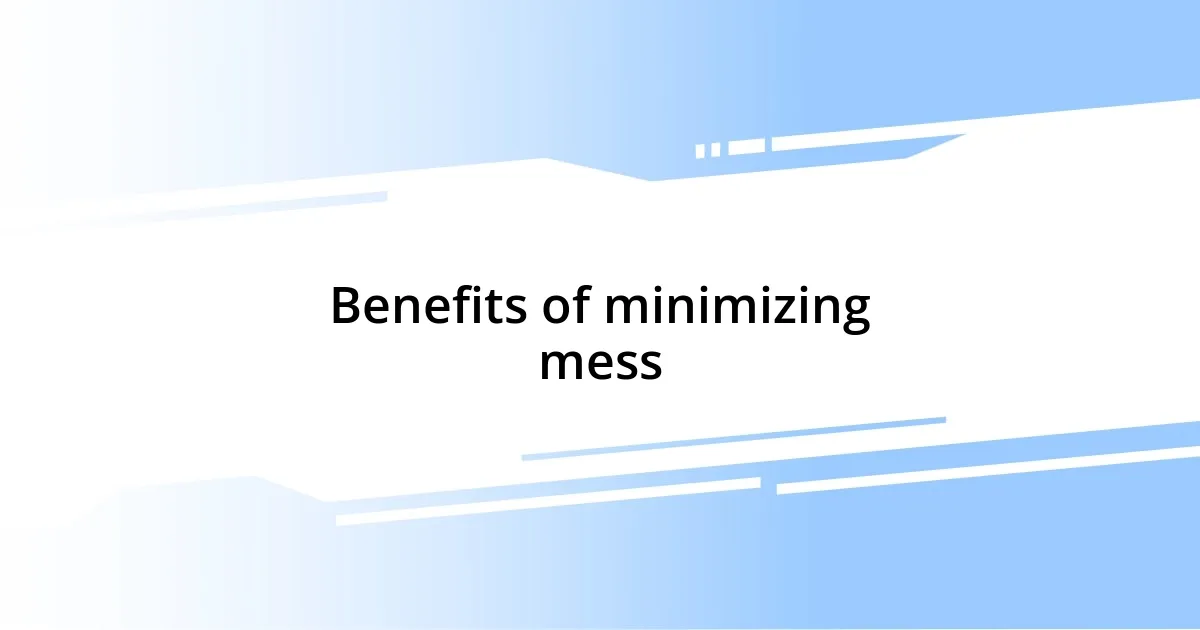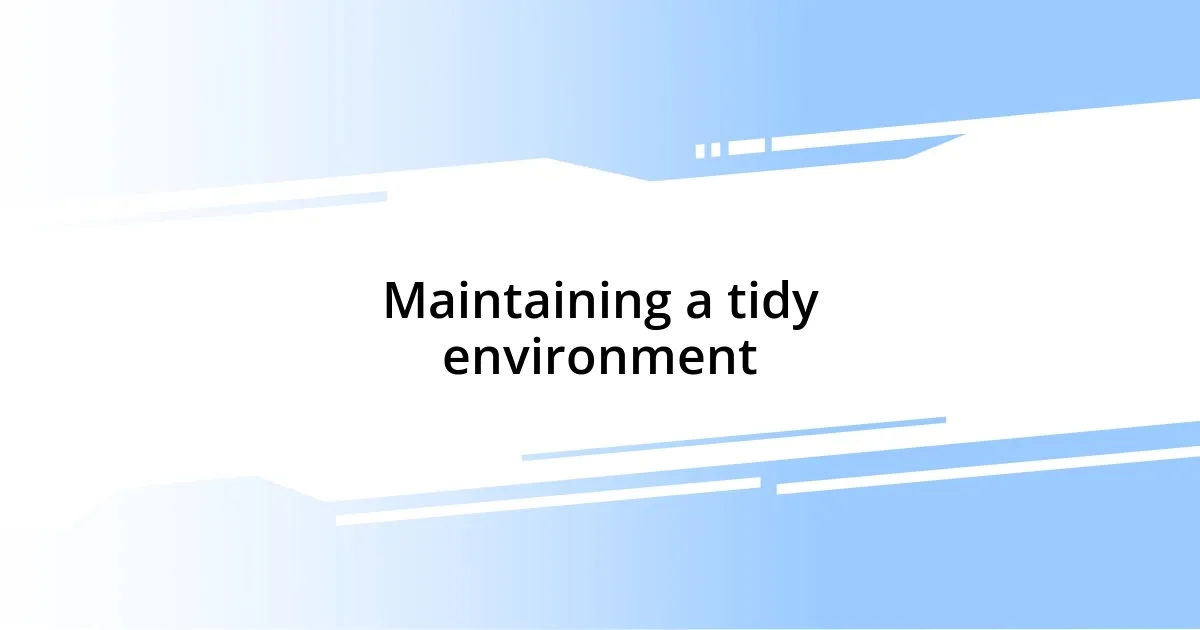Key takeaways:
- Mess can represent creativity and life, highlighting subjective perceptions based on individual values and lifestyles.
- Minimizing mess leads to reduced stress, increased efficiency, and enhanced creativity, benefiting mental clarity and productivity.
- Establishing a decluttering routine and using effective organizing techniques, like the “one-in, one-out” rule and storage solutions, fosters a harmonious environment.
- Adapting small, intentional habits over time contributes to long-term success in maintaining a tidy space and reinforcing positive changes.

Understanding the concept of mess
Mess can feel overwhelming, but it’s essential to understand what it truly represents. I remember a time when my kitchen looked like a tornado had swept through it after a cooking experiment gone wrong. That chaos, though unpleasant, sparked my realization that mess often reflects creativity and life in motion.
When we think about mess, we may picture clutter, dirt, or disorganization. But what if we also considered it as an opportunity? I often find that the messy moments—like when my kids leave their toys scattered everywhere—are reminders of their joy and imagination at play. How do you feel when you observe a little bit of disorder in your space? Does it bring frustration, or can you see the stories that led to that moment?
Ultimately, mess is subjective and tied closely to our lifestyles and values. For some, a few scattered books signify a thriving hobby, while for others, it might represent chaos. Reflecting on how mess impacts our emotions can lead to significant insights about what we prioritize in our lives. Have you ever cleaned up just to feel a sense of calm wash over you afterwards?

Benefits of minimizing mess
Minimizing mess offers several benefits that extend beyond just visual appeal. For instance, I’ve noticed that a tidier environment can lead to reduced stress and increased productivity. It’s incredible how a clean workspace can shift my mindset, allowing me to focus more effectively on the task at hand, rather than being distracted by clutter.
Another advantage I frequently experience is improved efficiency. When my work area is organized, I can find what I need quickly, eliminating the time wasted digging through piles of mess. I remember a day when I organized my desk, and it felt like unlocking a treasure chest—everything was suddenly at my fingertips, and I could breeze through my work with ease.
Lastly, maintaining a less messy space nurtures creativity and mental clarity. When I declutter my surroundings, it feels as though my mind follows suit, opening up pathways for new ideas. After tidying up after a crafting session, I often find that inspiration strikes—perhaps it’s because there’s room for new thoughts when the old ones are cleared away.
| Benefit | Description |
|---|---|
| Reduced Stress | A clean space can lead to a more peaceful mind. |
| Increased Efficiency | Organized spaces save time and enhance productivity. |
| Enhanced Creativity | A tidier environment often leads to clearer thinking and innovation. |

Creating a decluttering routine
Creating a decluttering routine is essential for maintaining a harmonious environment. I learned early on that setting aside a specific time each week to declutter made a remarkable difference in my home’s atmosphere. For me, it’s not just about tidiness; it’s a little ritual that brings clarity and a sense of control back into my life. Nearly every Saturday morning, I grab a cup of coffee and tackle one area—be it my bedroom dresser or the family room—and I relish the transformation that follows.
Here are some tips for establishing your decluttering routine:
- Schedule it: Set a specific day and time each week for decluttering, treating it as a non-negotiable appointment.
- Start small: Focus on one area or category at a time to avoid feeling overwhelmed—think about tackling just your nightstand or a single drawer.
- Use a timer: Dedicate 15-30 minutes to declutter; this time constraint often makes it easier to get started.
- Declutter with intention: Ask yourself if each item serves a purpose or brings you joy. If it doesn’t, consider letting it go.
- Celebrate progress: Acknowledge the small victories you achieve along the way; each cleared space deserves a little cheer!
As I developed this routine, I found a sense of accomplishment blooming within me. There’s something liberating about letting go of items that no longer serve a purpose; it’s as if I’m shedding a weight that has held me down. Just last month, while sorting through old magazines, I stumbled upon a reminder of a trip I took years ago. Instead of keeping the entire pile, I opted to gather a few favorites to preserve those memories while liberating myself from the clutter. This simple act reinforced my notion that decluttering isn’t just about the space; it’s about curating a life that feels genuine and fulfilling.

Effective organizing techniques
When it comes to effective organizing techniques, I often turn to the “one-in, one-out” rule. This simple strategy helps maintain balance in my space. Whenever I bring something new into my home—be it a book, a piece of clothing, or a gadget—I make it a point to let go of something else. It’s not just about control; it’s about being intentional with what I allow into my life. Have you ever felt how freeing it is to release something you no longer need? It changes the way I view my possessions.
Another technique that has made a significant impact is using storage bins and labels. I distinctly remember when I finally took the plunge and invested in a set of clear bins for my craft supplies. The moment I labeled them—“yarn,” “paints,” “tools”—I felt a sense of accomplishment wash over me. It wasn’t just organizing; it was transforming my entire crafting process. Now, each time I start a project, I can dive into creativity instead of spending precious minutes searching for materials. Doesn’t it feel great to know exactly where everything is?
Lastly, I’ve found that digital organization is just as important as physical organization. I make it a habit to clean up my digital files weekly. I’ve been in situations where important documents slipped through the cracks simply because I didn’t categorize them effectively. By creating folders on my computer and regularly backing things up, I can breathe easier knowing that everything has a designated spot. Have you ever lost something in the endless sea of desktop files? Trust me, organizing your digital space pays off immensely in peace of mind.

Strategic storage solutions
Finding the right storage solutions can completely transform how I utilize my space. I remember when I discovered the magic of vertical storage. Installing shelves in my garage allowed me to free up floor space and store seasonal items like holiday decorations and camping gear out of sight. Has anyone else felt that rush of relief when things don’t clutter your immediate view anymore? For me, it felt like my garage finally had room to breathe.
In my kitchen, I’ve embraced drawer dividers, and let me tell you, they are a game-changer. The first time I organized my utensils, I felt this surge of joy and satisfaction picking out a spatula in mere seconds—so different from the chaotic rummaging before! It’s fascinating how something as simple as neat compartments can turn the mundane act of cooking into a pleasant experience. Have you ever thought about how little tweaks in organization can directly improve your daily tasks?
Another solution I’ve found effective is utilizing under-bed storage. I’ve started placing out-of-season clothing in bins beneath my bed, which not only keeps my wardrobe organized but also frees up closet space for my everyday outfits. It’s incredible how that hidden space can work wonders in minimizing visual clutter. I often wonder how many of us overlook these spaces—why not harness their potential? Each small change contributes to an overall sense of clarity and calm in my home, making me eager to embrace even more creative storage ideas.

Maintaining a tidy environment
Maintaining a tidy environment often feels like a mental reset for me. I’ve noticed that pushing the limits of tidiness is as much about rhythm as it is about routine. Just recently, I committed to a nightly clean-up ritual—setting a timer for 10 minutes to quickly declutter my living space. It’s remarkable how much you can achieve in such a short time. Have you tried making cleaning a part of your winding down routine? It’s oddly therapeutic.
I also find that keeping surfaces clear makes a huge difference in how inviting my space feels. I used to leave my dining table cluttered with papers and mail, but when I finally designated a specific spot for these items—like a stylish inbox—it transformed not only the look of my table but also my willingness to host dinner parties. Have you ever noticed how a tidy dining area invites friends and family to gather? It’s like creating a welcoming atmosphere for connection.
Lastly, I’ve become a huge advocate for the “daily reset” concept, which means tidying up for just a few minutes each day. One morning, after a particularly messy week, I devoted 15 minutes to reordering my home office and found my productivity soared. It’s fascinating how a brief moment dedicated to tidiness can alter my mindset. Wouldn’t you agree that a tidy space allows the mind to be just as clear? It’s a small but powerful step towards sustaining that peaceful environment I strive for.

Adapting habits for long-term success
Adapting my habits for long-term success has been a journey, one that I believe begins with small, intentional changes. For instance, I realized that incorporating one new habit every month kept things manageable. When I started waking up just ten minutes early to tidy up, I noticed how it set a positive tone for my entire day. Have you ever tried making such a small change? The difference can be astonishing!
Another transformative habit I embraced was the “one in, one out” rule for my belongings. This practice has helped me keep clutter at bay while ensuring I only have items that truly serve a purpose. I distinctly remember the first time I tossed an old shirt after buying a new one. It felt liberating—like I was literally shedding old weight. How do you feel about letting go of things that no longer add value to your life?
Regularly reflecting on my progress has also been key. I started keeping a simple journal where I jot down my tidying successes and challenges. Just last week, I flipped through some old entries and was amazed at how far I’ve come. It’s not just about seeing the change in my space; it’s about recognizing the change in myself. Do you ever take time to celebrate your own progress? Doing so fuels motivation and reaffirms that adapting habits is indeed a worthwhile investment in a clutter-free life.














